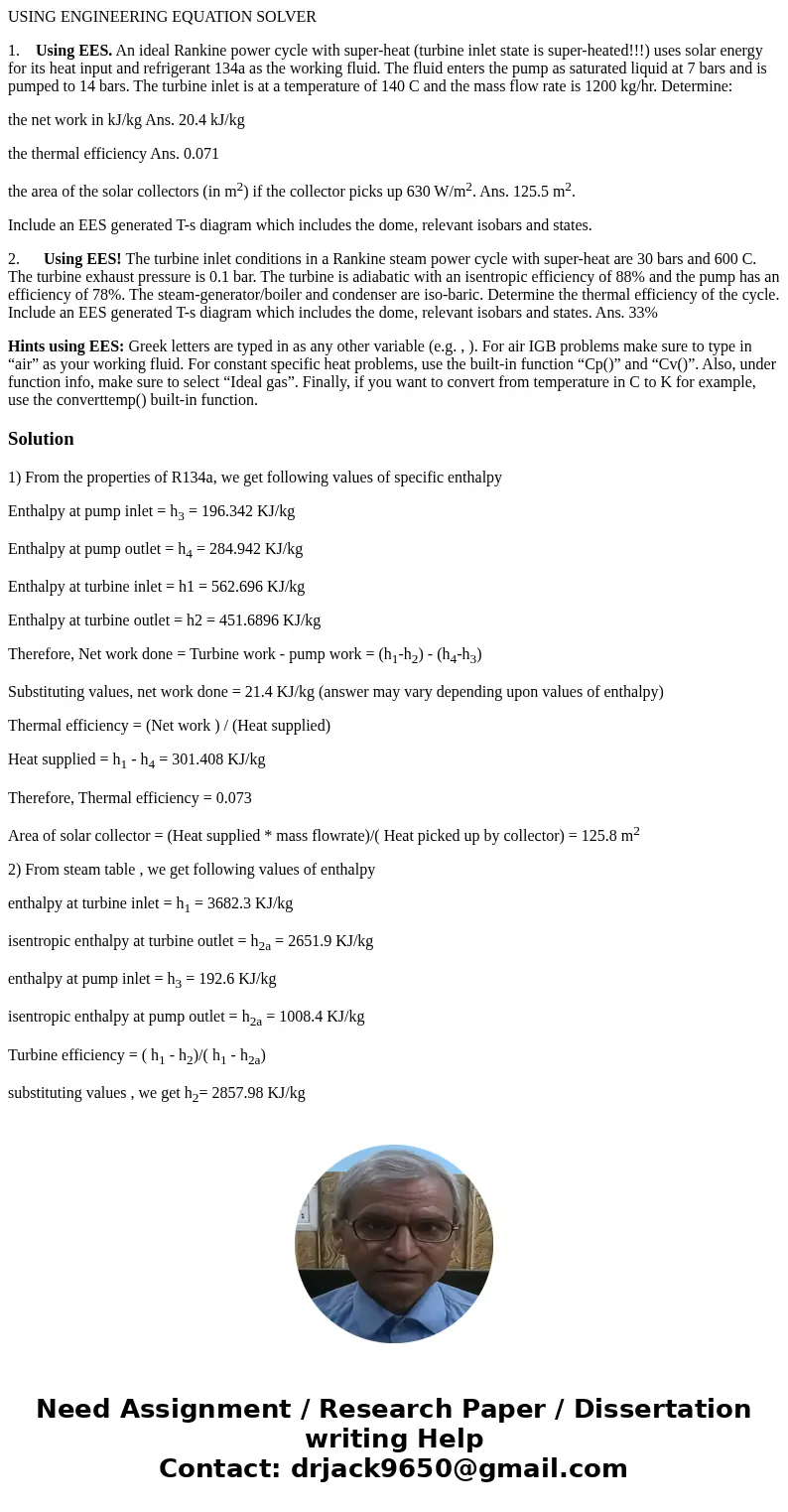USING ENGINEERING EQUATION SOLVER 1 Using EES An ideal Ranki
USING ENGINEERING EQUATION SOLVER
1. Using EES. An ideal Rankine power cycle with super-heat (turbine inlet state is super-heated!!!) uses solar energy for its heat input and refrigerant 134a as the working fluid. The fluid enters the pump as saturated liquid at 7 bars and is pumped to 14 bars. The turbine inlet is at a temperature of 140 C and the mass flow rate is 1200 kg/hr. Determine:
the net work in kJ/kg Ans. 20.4 kJ/kg
the thermal efficiency Ans. 0.071
the area of the solar collectors (in m2) if the collector picks up 630 W/m2. Ans. 125.5 m2.
Include an EES generated T-s diagram which includes the dome, relevant isobars and states.
2. Using EES! The turbine inlet conditions in a Rankine steam power cycle with super-heat are 30 bars and 600 C. The turbine exhaust pressure is 0.1 bar. The turbine is adiabatic with an isentropic efficiency of 88% and the pump has an efficiency of 78%. The steam-generator/boiler and condenser are iso-baric. Determine the thermal efficiency of the cycle. Include an EES generated T-s diagram which includes the dome, relevant isobars and states. Ans. 33%
Hints using EES: Greek letters are typed in as any other variable (e.g. , ). For air IGB problems make sure to type in “air” as your working fluid. For constant specific heat problems, use the built-in function “Cp()” and “Cv()”. Also, under function info, make sure to select “Ideal gas”. Finally, if you want to convert from temperature in C to K for example, use the converttemp() built-in function.
Solution
1) From the properties of R134a, we get following values of specific enthalpy
Enthalpy at pump inlet = h3 = 196.342 KJ/kg
Enthalpy at pump outlet = h4 = 284.942 KJ/kg
Enthalpy at turbine inlet = h1 = 562.696 KJ/kg
Enthalpy at turbine outlet = h2 = 451.6896 KJ/kg
Therefore, Net work done = Turbine work - pump work = (h1-h2) - (h4-h3)
Substituting values, net work done = 21.4 KJ/kg (answer may vary depending upon values of enthalpy)
Thermal efficiency = (Net work ) / (Heat supplied)
Heat supplied = h1 - h4 = 301.408 KJ/kg
Therefore, Thermal efficiency = 0.073
Area of solar collector = (Heat supplied * mass flowrate)/( Heat picked up by collector) = 125.8 m2
2) From steam table , we get following values of enthalpy
enthalpy at turbine inlet = h1 = 3682.3 KJ/kg
isentropic enthalpy at turbine outlet = h2a = 2651.9 KJ/kg
enthalpy at pump inlet = h3 = 192.6 KJ/kg
isentropic enthalpy at pump outlet = h2a = 1008.4 KJ/kg
Turbine efficiency = ( h1 - h2)/( h1 - h2a)
substituting values , we get h2= 2857.98 KJ/kg
Pump efficiency = ( h4a- h3)/(h4 - h3)
substituting values , we get h4= 828.924 KJ/kg
Thermal efficiency of cycle = 1 - ((h2 - h3)/(h1- h4)) = 0.33 = 33%

 Homework Sourse
Homework Sourse